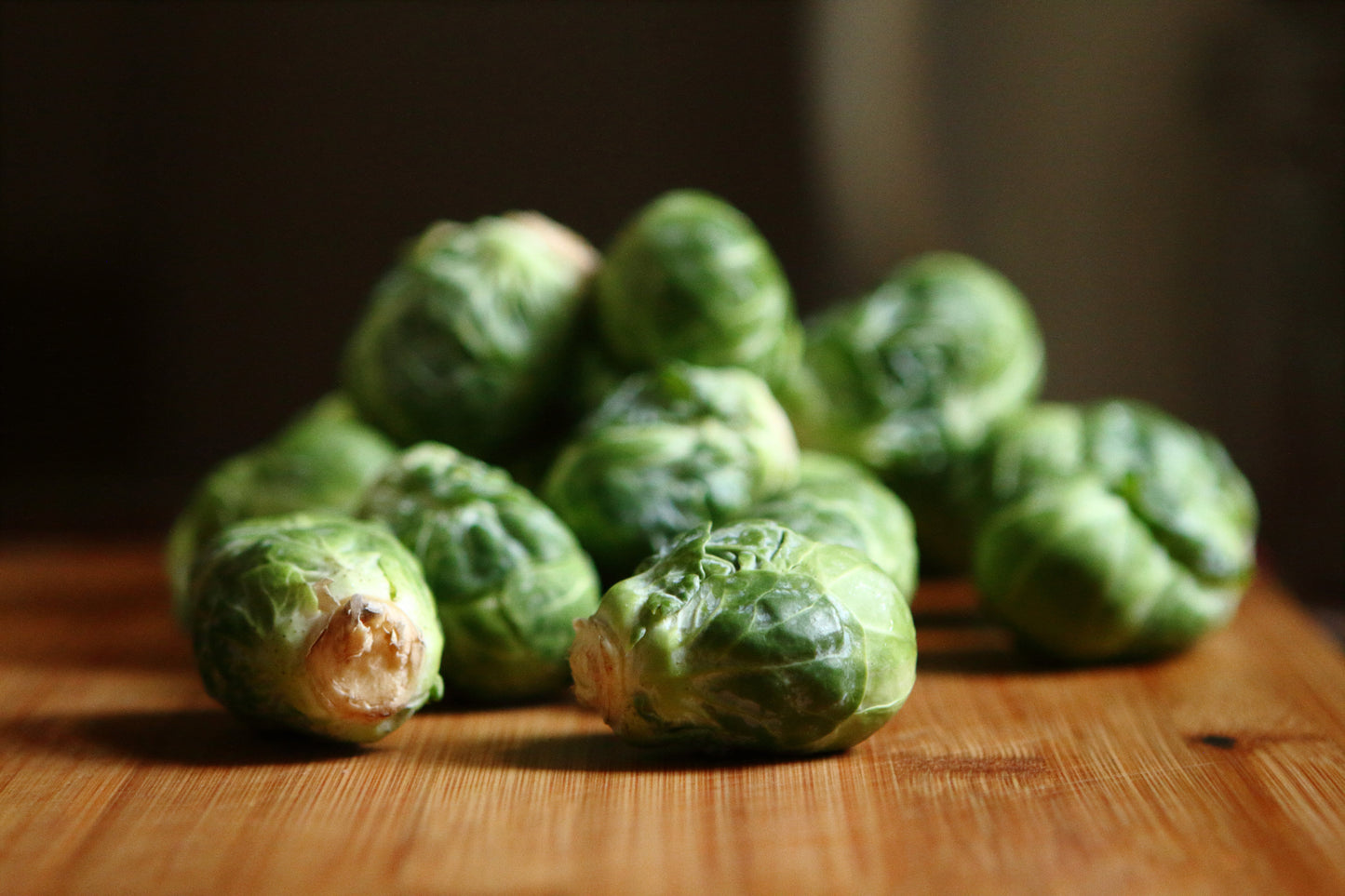
Although modern technology and worldwide food distribution make most produce available year round, there is benefit to eating seasonally. Foods are typically fresher, more nutritious and affordable when in season. Here are some of the healthiest fruits and vegetables to eat up this Fall & Winter--especially if you're trying to keep your waistline in check. They pack a nutritional punch while being low in calories, which means you can pile these on your plate!
1. Brussels Sprouts
Brussels sprouts are among the healthiest vegetables all around. Looking like miniature cabbages, they are not surprisingly part of the same family as cabbage and other leafy greens, Brassicaceae. They are also referred to as cruciferous vegetables.- Richest in: Vitamin K, vitamin C, vitamin B6, B1, folate, manganese, fiber, choline, copper, potassium and phosphorous
- Contains trace amounts of: Omega 3, iron, vitamin B2, pantothenic acid, magnesium, vitamin A (beta carotene), vitamin B3
-
Beneficial plant compounds:
- Glucosinolates - compounds shown to have anti-oxidant and anti-inflammatory effects which protect against various cancers; they do this by helping the body to excrete carcinogens; glucosinolates have also been linked to heart health; the glucosinolate content found in brussels is greater than any other in the cruciferous family.
- Lutein & zeaxanthin - potent antioxidants; may protect against eye disease
- Flavonoids like quercetin, isorhamnetin, kaempferol, and ferulic acid - best known for their antioxidant and anti-inflammatory effects as well as beneficial for the cardiovascular and nervous systems.
2. Winter Squash
Despite its family name, winter squash are the quintessential fall vegetables. With over 20 varieties including acorn, pumpkin, butternut, spaghetti, delicata, and hubbard (to name a few), winter squash are a highly nutritious and low-calorie source of complex carbs & fiber. Because of this winter squash are considered a low glycemic foods which may help to regulate blood sugar. What's neater is that their seeds are also edible and nutritious.- Richest in: Vitamin A, C, B6, B2, fiber, manganese, copper, potassium,
- Contains trace amounts of: Pantothenic acid, folate, vitamin K, magnesium, B3, omega 3
-
Beneficial plant compounds:
- Alpha & beta-carotene - responsible for the rich orange to yellowish hues in squash; they are converted into vitamin A; known as powerful antioxidants
- Lutein & zeaxanthin - potent antioxidants; may protect against eye disease
- Alpha-linolenic acid - plant-based omega 3; anti-inflammatory benefits
3. Cabbage
Along with Brussels sprouts, cabbage is part of the cruciferous family and also a rich source of cancer preventive glucosinolates. Different varieties of cabbage have different patterns of glucosinolates, so you can widen your benefits by consuming different types. White cabbage is the most commonly consumed in the US and provides approximately 50 mg of polyphenols in a half cup serving. Red cabbage provides more than double the polyphenols in the same serving size due to its red-pigment anthocyanins.- Richest in: Vitamin K, C, B6, manganese, fiber, potassium
- Contains trace amounts of: Copper, vitamin B1, B2, folate, choline, phosphorous, selenium, magnesium, iron, calcium, pantothenic acid, vitamin B3
-
Beneficial plant compounds:
- Glucosinolates - the body can convert glucosinolates into isothiocyanate which are known to be protective against various types of cancers; help reduce oxidative stress in the body.
- Flavonoids like quercetin and kaempferol - potent antioxidants which scavenge damaging particles in the body; also may be protective against various metabolic diseases
- Anthocyanins - responsible for the red to purple-ish hues in red cabbage; potent antioxidant & anti-inflammatory
4. Sweet potatoes
These deliciously sweet underground tubers are often confused with Yams. Sweet potatoes are most commonly orange but they can also be white or purple fleshed. Purple fleshed sweet potatoes have the highest antioxidant content. In general sweet potatoes are more nutritious than regular potatoes due to slightly higher levels of vitamins/minerals, fiber content and beneficial plant compounds. The complex carb and fiber content of sweet potatoes may help to regulate blood sugar although they are considered a medium to high glycemic index (GI) food. Cooking methods like frying and baking may increase the GI, whereas boiling has been linked to a lower GI.- Richest in: Vitamin A, C, B6, B3, B1, B2, manganese, copper, pantothenic acid, biotin, potassium, fiber, phosphorous
- Contains trace amounts of: Vitamin E, K, magnesium, calcium, iron
-
Beneficial plant compounds:
- Beta carotene - found in orange-fleshed sweet potato; starting material for Vitamin A; potent antioxidant
- Anthocyanin - found in purple-fleshed sweet potato; potent antioxidant & anti-inflammatory
- Chlorogenic acid - may help to reduce blood sugar levels by blocking the absorption of carbs
- Sporamins - unique protein compounds which appear to have antioxidant properties.
Try our Sweet Potato Pie Smoothie
5. Apples
Apples may not seem like your go-to superfood, but they do have redeeming qualities which may indeed "keep the doctor away." There are more than 7,500 varieties of apple, 2500 of which are grown in the US. Many of apple's nutrients and beneficial plant compounds are concentrated in the peel, so eating the whole fruit is more beneficial than a peeled version. Being over 80% water makes apples a low-calorie, yet filling food option especially for weight management. Pectin, a type of soluble fiber found in apples has been linked to improved digestion, lowered cholesterol levels and blood sugar control. In general, apples have been associated with reduced risk of lung-cancer.- Richest in: fiber (both soluble and insoluble), vitamin C
- Contains trace amounts of: biotin, copper, potassium, chromium, vitamin B2, B6, K
-
Beneficial plant compounds:
- Quercetin - potent antioxidant and anti-inflammatory found mainly in the skin of apples; may help to regulate blood sugar
- Flavonols: kaempferol & myricetin - being researched as anti-obesity and anti-cancer agents
- Chlorogenic acid - antioxidant; may help to reduce blood sugar levels by blocking the absorption of carbs
- Anthocyanin - responsible for the reddish pigment in apples; potent antioxidant and anti-inflammatory
- Catechin & Epicatechin - potent antioxidants; beneficial effects on blood vessels and reducing oxidation from fat metabolism
Try our Healthy Apple Pie Smoothie
6. Pears
Although there are countless varieties, 10 varieties of pear are grown in Oregon and Washington. These states produce 84% of the nation’s fresh pear crop. Pears are nutritionally similar to apples--they too contain most of their beneficial plant compounds in their skin, and will vary based on the pigment color. These compounds (along with its fiber content) are thought to be a major reason for pear's associated health benefits to blood sugar & cholesterol. Pears also contain pectin. It's high water content also makes it a filling and low-calorie fruit for weight management.- Richest in: fiber (both soluble & insoluble), copper, vitamin C & K
- Contains trace amounts of: potassium, manganese, vitamin B2
-
Beneficial plant compounds:
- Quercetin - potent antioxidant and anti-inflammatory found mainly in the skin of pears; may protect against various metabolic diseases
- Beta carotene (mostly beta) - responsible for the yellowish & orange color on some pears; converts into vitamin A; powerful antioxidant
- Lutein & zeaxanthin - potent antioxidants; may protect against eye disease
- Chlorogenic acid - antioxidant; associated with lower blood pressure
- Cyanidin - responsible for the reddish color on some pears; reduces oxidative stress in the body and damage to blood vessels
- Epicatechin - potent antioxidant; beneficial effects on blood vessels and reducing oxidation from fat metabolism
Try our Pear Pineapple Green Smoothie!
7. Cranberries
When it comes to beneficial plant compounds, cranberries are a nutritional powerhouse. They contain 5 categories (and over 12 different kinds) of beneficial compounds including phenolic acids, proanthocyanidins (PACs), anthocyanins, flavonoids and triterpenoids which are all well studied for their antioxidant, anti-inflammatory and cancer preventive properties. Scientist believe that it is the PACs in cranberries that may be responsible for helping to prevent urinary tract infections rather than their acidity. Unfortunately, most of these compounds are lost when cranberries are processed into dried snacks, juice, etc. (the forms in which most Americans consume cranberries). Raw cranberries are bitter and sour. But one way you could eat them raw would be to add a handful into a smoothie.- Richest in: Manganese, vitamin C, vitamin E, fiber
- Contains trace amounts of: Vitamin E, copper, vitamin K, pantothenic acid
-
Beneficial plant compounds:
- PACs - potent antioxidant; believed to be effective at preventing UTIs & supporting the immune system
- Cyanidin & Peonidin - types of anthocyanidin; antioxidants; responsible for the rich red color of cranberries
- Lutein & zeaxanthin - potent antioxidants; may protect against eye disease
- Quercetin & Myricetin - types of flavonols; antioxidant and anti-inflammatory properties; may protect against various metabolic diseases
- Epicatechin - antioxidant properties; beneficial effects on blood vessels and reducing oxidation from fat metabolism
- Ursolic acid - found mainly in the peel of cranberries; unconfirmed benefits, but emerging research suggests it can stop certain cancer cells from growing
8. Pomegranates
Although a bit challenging to eat, pomegranate's nutritional benefits are well worth the peeling battle. Like cranberries, pomegranates' health benefits are mainly attributed to the beneficial plant compounds they contain. Each pomegranate contains hundreds of arils (seed/juice sacs) and like other fruits, is best eaten whole (seeds) rather than their juice alone. However, some studies have shown benefits to drinking pomegranate juice as well. Pomegranates have been linked to breast and prostate cancer prevention, improved memory, lowered joint inflammation and better heart health among other things.- Richest in: Fiber, vitamin C, K, potassium, folate,
- Contains trace amounts of: Magnesium, phosphorous, pantothenic acid, riboflavin
-
Beneficial plant compounds:
- Punicalagins – antioxidant; has greater activity than what is found in green tea & red wine; also known to have anti-flammatory benefit
- Punicic acid – oil in the seeds; a type of fatty acid that has been shown to cause fat loss
- Catechin, epigallocatechin & gallocatechin - powerful antioxidants
